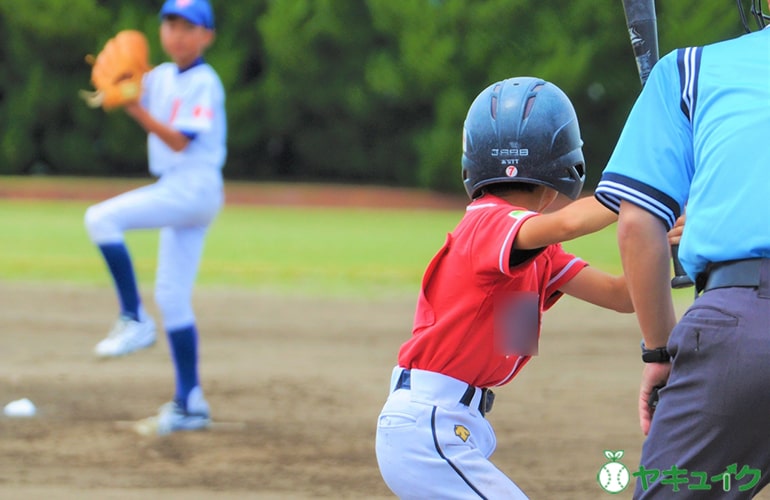
Baseball is a sport that requires both skill and physical strength.
Ball speed is a key factor, especially for pitchers.
For elementary school baseball players, what is the average pitch speed and how they can improve that speed are topics of interest to many parents, coaches, and players themselves.
In this article, we will cover a wide range of topics, from basic knowledge to specific training methods and advice from professional athletes.
This will provide children with information that will help them improve their pitching speed and support more enjoyable and effective baseball practice.
Each section also introduces factors that affect pitching speed, training methods, and mental approaches, so be sure to use it as a reference.
目次
- 1 What is the average pitch speed in elementary school baseball?
- 2 Factors that affect pitch speed
- 3 Training methods to improve pitching speed
- 4 Specific training programs for elementary school students
- 5 Tools and gear to help improve pitching speed
- 6 Mental approach to improving pitching speed
- 7 Tips to improve pitching speed from professional players
What is the average pitch speed in elementary school baseball?
The average pitch speed in elementary school baseball varies depending on the player’s stage of development and the quality of training.
Here we will explain in detail how to measure the pitching speed of elementary school students, the national average data, and the differences in pitching speed by age and grade.
How to measure average pitch speed for elementary school students
When measuring the pitching speed of elementary school students, there are a few points to keep in mind in order to obtain accurate data.
Below are some common measurement methods.
-
Using a radar gun: A radar gun is often used to measure pitch speed. This is the most reliable method as it gives a real-time measurement of the ball’s speed as it is thrown by the pitcher.
-
Preparation of the measurement environment: In order to measure the ball speed accurately, it is recommended to perform the measurement indoors where there is no influence of wind or in calm weather with little wind. It is also important to throw from a flat and safe mound.
-
Multiple pitches: By throwing the ball several times and taking the average value instead of throwing it once, the ball speed can be measured more accurately. This minimizes the error of a single measurement.
-
Proper warm-up: Before measuring ball speed, it is important to warm up properly and ensure that your muscles and joints are sufficiently warmed up. If you do not warm up properly, not only will the ball speed not be measured accurately, but you will also increase the risk of injury.
National average data for elementary school students’ pitching speed
The pitching speed of elementary school students can vary greatly across the country.
Here is some general data.
-
Average pitch speed: The average pitch speed of elementary school students varies depending on their grade, physique, and the quality of their training, but generally falls within the following ranges. The average pitch speed of lower grades (1st to 3rd grade) is around 60km/h, that of middle grades (4th to 5th grade) is around 70km/h, and that of upper grades (6th grade) is around 80km/h.
-
Top-level pitching speed: Top-level elementary school pitchers can record pitching speeds of over 80km/h. Players who are particularly well-built and have excellent pitching form can throw at speeds approaching 90km/h.
-
Regional differences: There are also regional differences in pitch speed. In areas where baseball is popular, there tends to be more players with fast pitch speeds. This is thought to be influenced by factors such as the training environment, the quality of coaches, and the number of players.
Differences in pitching speed by age and grade
The pitching speed of elementary school students varies greatly depending on their age and grade.
Below are more details on the differences in pitching speed by age and grade.
-
Lower grades (1st to 3rd grade): In this age group, the body is still developing, and the average pitching speed is about 50km/h to 60km/h. During this period, it is important to learn basic pitching form and build up physical strength.
-
Middle school (4th to 5th grade): As the body size and muscle strength gradually grow, the average pitching speed increases to about 60km/h to 70km/h. In this age group, more specific pitching technique improvement is required.
-
Upper grades (6th grade): As the physique grows and muscle strength increases, the average pitch speed increases to about 70km/h to 80km/h. It is not uncommon for particularly excellent players to record pitch speeds of over 80km/h.
-
Individual differences in growth: Since there are individual differences in the speed of growth, there is a large variation in pitching speed even among students of the same grade. It is important to provide instruction that is tailored to the individual’s growth without forcing them.
Understanding the average pitch speed in elementary school baseball can be helpful when considering appropriate training methods and teaching policies.
This will allow children to improve their skills safely and effectively.

Factors that affect pitch speed
Pitch speed in elementary school baseball is influenced by many factors.
Here, we will take a closer look at the factors that affect pitching speed, such as physique and muscle strength, pitching form and technique, and the amount and quality of practice.
The influence of size and strength
Size and strength are important factors that directly affect pitch velocity.
The details are explained below.
-
Physical size: A player with a larger physique can transmit more power to the ball. As height and weight increase, the force exerted during pitching also increases. This is due to the length of the arms and the increase in muscle mass. A player with a larger physique can swing his arms further, which results in a faster pitch.
-
Strength: The strength required for pitching is in the shoulders, arms, chest, and lower body. In particular, shoulder and arm strength is important for imparting speed to the ball. Lower body strength also contributes greatly to stability and power transmission during pitching. A strong lower body is the foundation that supports the series of movements from the start of the pitching motion to the release of the ball.
-
Training: Proper training is necessary to improve muscle strength. It is necessary to train the muscles of the whole body in a balanced manner through weight training and core training. In particular, by strengthening the inner muscles around the shoulders, it is possible to improve pitching speed while preventing injuries.
The importance of pitching form and technique
Proper pitching form and technique are key factors in improving pitch velocity.
Here we will explain these points in detail.
-
Release point: It is important that the release point is consistent. If the release point is stable, the force can be transferred to the ball efficiently. If the release is too early or too late, the force will be dispersed, causing the ball speed to drop.
-
Body coordination: It is important to coordinate the movements of the whole body when pitching. By coordinating the power of not only your shoulders and arms but also your lower body and core, you can transmit maximum power to the ball. In particular, smoothly coordinating the movements of your lower body and upper body is the key to improving your pitching speed.
-
Pitching motion: To acquire the correct pitching motion, repeated practice is necessary. It is also effective to check your own form on video under the guidance of a coach. By repeatedly fine-tuning your form, you can establish the ideal pitching form.
The impact of quantity and quality of practice
The amount and quality of practice also play a major role in ball speed.
The details are explained below.
-
Appropriate amount of practice: It is important to ensure that you practice the right amount. Excessive practice can lead to injury, and too little practice can prevent you from improving your technique. Creating a balanced practice plan is essential to improving your pitching speed.
-
Quality practice: It is also important to improve the quality of practice. Quality practice means practice that has a specific goal and is planned. For example, comprehensive practice that combines various elements such as pitching practice to increase pitching speed, muscle strengthening training, and stretching to increase flexibility is necessary.
-
Feedback and Adjustments: It is important to receive feedback from your coach during practice. Your coach will point out areas for improvement in your pitching form and movements, and you can make adjustments accordingly to effectively improve your technique.
Factors that influence pitching speed include physique and strength, pitching form and technique, and the amount and quality of practice.
By incorporating these elements in a well-balanced way during training, elementary school baseball players will be able to effectively improve their pitching speed.

Training methods to improve pitching speed
Systematic and planned training is essential to improve pitching speed.
Below we’ll take a closer look at strength training, effective throwing drills, and the importance of flexibility and stretching.
Strength Training Basics
Strength training is the foundation for improving pitching velocity.
By doing proper strength training, you will be able to efficiently exert the force required when throwing the ball.
-
Strengthening the muscles of the whole body: Throwing requires muscle strength of the whole body. In particular, the muscle strength of the shoulders, arms, chest, and lower body is important. Train the muscle strength of the whole body in a balanced manner through weight training and bodyweight training.
-
Shoulder and arm training: Strengthening the muscles around the shoulders improves stability and power transfer when throwing. Training with dumbbells or tubes is effective. It is also important to strengthen the forearms, biceps, and triceps.
-
Core training: Core strength is essential for efficiently transferring power when throwing the ball. By incorporating core training such as planks, side planks, and Russian twists, you can increase the stability of your pitching form.
-
Strengthen your lower body: Lower body strength is important for starting the pitching motion. Do exercises such as squats, lunges, and leg presses to strengthen your lower body. Strengthening the front and back of your thighs and calves is particularly effective.
Effective pitching practice
Pitching practice is also essential to improving pitching speed.
It is important to learn the correct pitching form and hone your skills through repetitive practice.
-
Form check: Check your pitching form with the help of a coach or video. Maintaining the correct form will help you transfer power to the ball efficiently.
-
Repetitive practice: Daily repetitive practice is necessary. By repeating the same movements, you can form muscle memory and stabilize your form. It is important to decide the number of pitches and do it in a planned manner.
-
Use a speed gun: You can check the effectiveness of your training by measuring your pitching speed with a speed gun. You can maintain your motivation by setting goals and checking your progress.
-
Varied pitching: By practicing pitching not only straight balls but also curveballs, sliders, and other breaking balls, you can improve your overall pitching technique.
The importance of flexibility and stretching
Flexibility and stretching are key components to improving pitching velocity while preventing injury.
The throwing motion involves many joints and muscles, so it is important to maintain flexibility.
-
Dynamic Stretching: As a warm-up before pitching, do some dynamic stretching. Stretching that includes shoulder rotations, arm swings, and hip movements will help prepare your body for pitching.
-
Static Stretching: After pitching or training, perform static stretches to relax your muscles. Focusing on the shoulders, arms, back and leg muscles will help relieve muscle tension and promote recovery.
-
Yoga and Pilates: Yoga and Pilates are great for improving flexibility and strengthening your core. Doing these exercises regularly can help you maintain your flexibility while improving the stability of your pitching form.
-
Range of motion of joints: Stretching to increase the range of motion of the shoulders, elbows, and hips is also important. By keeping the movement of the joints smooth, the power transmission during pitching becomes more efficient, improving the ball speed.
To improve pitching velocity, it is important to balance strength training, effective pitching practice, and flexibility and stretching.
By combining these elements in comprehensive training, you can effectively improve your pitching speed.

Specific training programs for elementary school students
Planned training is essential to improve your pitching speed.
Here we introduce a specific training program for elementary school students.
We will explain in detail the weekly training menu, points to pay attention to during training, and how to monitor your training results.
To implement an effective training program, it is important to plan your weekly menu.
Below is an example of a one week training menu.
Monday: Basic Training
- Warm-up (15 mins): Jogging, dynamic stretching
- Basic pitching practice (30 minutes): Practice throwing straight balls only, check form
- Strength training (20 minutes): push-ups, squats, sit-ups
- Cool Down (10 min): Static Stretching
Tuesday: Skills training
- Warm-up (15 mins): Jump rope, stretching
- Pitching technique practice (30 minutes): Check pitching form, practice curveballs
- Field practice (20 minutes): catch ball, fielding
- Cool Down (10 mins): Relaxing Stretching
Wednesday: Rest day
- Light exercise (30 minutes): walking, light jogging
- Stretching (15 mins): Full body static stretches
Thursday: Advanced Training
- Warm-up (15 mins): Stretching, light running
- High-intensity pitching practice (30 minutes): Measure the ball speed using a speed gun, aiming for the fastest pitch
- Strength training (20 mins): dumbbell exercises, core training
- Cool down (10 min): Yoga, stretching
Friday: Skills training
- Warm-up (15 mins): Dynamic Stretching
- Pitching technique practice (30 minutes): Pitching drills, confirmation of release point
- Strength training (20 mins): Lunges, planks, balance ball exercises
- Cool Down (10 min): Relaxation Stretching
Saturday: General training
- Warm-up (15 mins): Jogging, stretching
- General Practice (30 mins): Pitching, Batting, Fielding
- Strength Training (20 mins): Full body strength training
- Cool Down (10 min): Static Stretching
Sunday: Recovery Day
- Light exercise (30 minutes): cycling, walking
- Stretching (15 mins): Full body static stretches
Important points to note during training
To ensure effective training, there are a few important points to keep in mind.
-
Proper Warm-up and Cool-down: Warming up is important to warm your muscles and prevent injury, while a proper cool-down helps your muscles recover better after training.
-
Check your form: It is important to maintain your pitching form correctly. If your form is poor, you will not be able to throw efficiently and you will be at a higher risk of injury. It is effective to receive guidance from a coach or to watch a video of your own pitching.
-
Balanced strength training: It is important to train all the muscles of the body in a balanced manner, not just specific muscles. In particular, strengthening the core and lower body muscles will improve stability and power transmission when throwing the ball.
-
The Importance of Rest: Getting adequate rest between training sessions is essential for your body to recover and grow. Not doing so can lead to excessive fatigue and injury.
How to check your progress
Regular evaluation and feedback is important to ensure training is effective.
Here’s how to check your training progress:
-
Measure your ball speed: Use a speed gun to measure your ball speed periodically and check the effectiveness of your training. Set goals and record your progress to keep track of your progress.
-
Form Check: Use a video camera to record your pitching form and review it with your coach or teammates. By finding areas to improve and correcting them, you can pitch more efficiently.
-
Muscle Strength Testing: Regularly perform muscle strength tests to monitor the effectiveness of your training. By checking whether your muscle strength is improving, you can evaluate the effectiveness of your training.
-
Feedback: It’s important to be open to feedback from your coach and teammates. Another person’s perspective can help you see areas for improvement that you might not see on your own.
By implementing this type of training program and continuing to train while following the precautions, even elementary school students can effectively improve their pitching speed.
Regularly monitoring your training progress and working towards your goals is the key to success.

Tools and gear to help improve pitching speed
Using the right tools and gear is key to improving your pitching velocity.
Here we will explain in detail about pitching practice equipment, effective training gear, and how to choose the right baseball equipment.
Introduction of pitching practice equipment
Using the right equipment can improve the effectiveness of your pitching practice.
Below are some pitching practice tools that will help you improve your pitching speed.
-
Speed Gun: A speed gun is a tool for measuring the speed of a pitch. By measuring the speed of a pitch regularly, you can check the effectiveness of your training and set goals. By using a speed gun, you can understand your current pitch speed and plan your training to improve it.
-
Pitching machines: Pitching machines are extremely effective in improving pitching accuracy and speed. They can reproduce a variety of speeds and pitch types, allowing you to practice in a situation close to a real game. In particular, by repeatedly practicing at a constant speed, you can improve the stability of your form and the timing of your release.
-
Throwing net: A throwing net is a convenient tool for practicing throwing indoors and outdoors. By providing a target, you can practice control and accuracy. The net also allows you to retrieve balls efficiently, allowing you to practice many throws in a short amount of time.
-
Wrist weights: Using wrist weights can help strengthen your arm muscles and improve your pitching speed. By choosing the right weight for your training and practicing with resistance, you can increase your strength and endurance.
Effective training gear
By using effective training gear, you can further increase the effectiveness of your training to improve your pitching speed.
Here are some particularly useful pieces of training gear:
-
Balance ball: Balance balls are very effective for core training. Strengthening the core muscles improves stability and power transmission when throwing. It is effective to incorporate exercises that strengthen the core muscles using a balance ball.
-
Training bands: Training bands are tools for strengthening shoulder and arm muscles. They are lightweight and easy to carry, so you can train anywhere. By focusing on training the inner muscles around the shoulders, you can improve stability and ball speed when pitching.
-
Medicine ball: Using a medicine ball allows you to train the muscles of both your upper and lower body at the same time. In particular, by performing training that mimics the pitching motion, you can strengthen your muscles in a way that is close to the actual game.
-
Foam Roller: Foam rollers are used to improve muscle recovery and flexibility. By using a foam roller after training, you can reduce muscle fatigue and keep your muscles flexible.
How to Choose the Right Baseball Equipment
By choosing the right baseball equipment, you can get the most out of your training.
Here are some tips on how to choose baseball equipment:
-
Gloves: It is important to choose a glove that fits your hand. A glove that does not fit properly will affect your control when pitching, so it is a good idea to try it on before choosing one. Consider the softness and material, and choose one that is easy to use.
-
Shoes: It is important to choose baseball shoes that fit your feet. Shoes that do not fit properly will restrict your foot movement and cause injuries. Consider cushioning and grip and choose shoes that suit your playing style.
-
Bat: It is important to choose a bat with the right length and weight. By choosing a bat that matches your swing, you can maximize your hitting power. Consider the material and shape of the bat and choose the bat that is best suited to you.
-
Protectors: Protectors are important for safety. In particular, catchers and batters can reduce the risk of injury by wearing the right protectors. Check the size and fit and choose one that allows you to play safely and comfortably.
Using the right tools and gear will help you get the most out of your velocity training.
By utilizing these tools and gear and doing planned training, it is possible to steadily improve your pitching speed.

Mental approach to improving pitching speed
In order to improve pitching speed, not only physical training but also a mental approach is extremely important.
Here we will explain in detail the importance of mental strengthening, how to maintain motivation, and how to deal with pressure during a match.
The importance of mental training
Mental fitness is an essential element for maximizing performance.
Mentally strong players are able to stay calm and make the best decisions in difficult situations.
-
Maintaining concentration: Maintaining high levels of concentration improves performance during training and games. To improve concentration, it is effective to train your concentration on a daily basis. For example, meditation and mindfulness practice can be helpful.
-
Mental endurance: To endure long training and competition hours, you need mental endurance. This comes from improving your ability to cope with stress and fatigue. Develop mental toughness through relaxation techniques and positive self-talk.
-
Motivation: Maintaining high motivation will increase your motivation to train, which will ultimately lead to improved pitching speed. Setting clear goals for yourself and working hard to achieve them will help you stay motivated.
How to stay motivated
Staying motivated is essential to achieving your long-term goals.
Here are some ways to stay motivated:
-
Goal setting: It is important to set clear goals. Set short-term and long-term goals, and reward yourself every time you achieve them to increase your motivation. For example, set a specific goal such as “increase my pitching speed by 5km/h this month.”
-
Record your progress: By recording your training progress, you can easily realize your own growth. By recording your ball speed and training details in a notebook or app and reviewing them regularly, you can get a sense of accomplishment.
-
Positive self-talk: Speaking positive words to yourself can help you stay motivated. Even when you fail, you can maintain a positive attitude by telling yourself, “I’ll do better next time.”
-
Support system: Having supportive people like family, friends, and coaches can play a big role in keeping you motivated. Having someone to listen and give you advice on a regular basis can help you stay motivated.
Dealing with pressure in a match
Being able to handle the pressure of a match is important to perform at your best.
Here are some ways to deal with pressure during a match:
-
Use breathing techniques: If you feel nervous during a match, you can relax by taking deep breaths. By using abdominal breathing, inhaling slowly and deeply and exhaling slowly, you can calm your heart rate and regain your composure.
-
Establish a routine: Having a routine before and during a game can help you feel more at ease. A routine can be a specific action you take before pitching or a set of actions that make you feel comfortable. This can help you feel less pressured.
-
Positive imagery training: Positive imagery training before a game will help you play with confidence. Visualizing a successful throw or a good outcome will increase the odds of the same happening in real life.
-
Improve your self-talk: Speaking positive words to yourself during a match can help reduce pressure. For example, repeating phrases to yourself like “I can do it” or “Stay calm” can help ease tension and keep you focused.
Strengthening your mental state, maintaining motivation, and dealing with pressure during games are all very important in improving your pitching speed.
By adopting these mental approaches, players can perform at a higher level and effectively improve their pitch velocity.

Tips to improve pitching speed from professional players
In order to improve your pitching speed, it is very effective to study the training routines and pitching techniques of professional baseball players.
Here we take a detailed look at professional baseball players’ training routines, the pitching techniques they use, as well as interviews and advice.
Professional baseball player training routine
The training routines of professional baseball players are packed with elements that are essential for improving pitching speed.
Below is a typical training routine for a professional baseball player.
-
Warm-up: Professional athletes always warm up before training, incorporating light jogging and dynamic stretching to warm up the muscles and increase the range of motion of the joints.
-
Strength training: Strength training aims to develop balanced muscle strength throughout the body, with particular emphasis on strengthening the shoulders, arms, chest, core, and lower body. Basic weight training exercises such as squats, bench presses, and deadlifts are included.
-
Pitching practice: In pitching practice, we will mix straight and curveballs to recreate a situation close to a real game. We will also use a speed gun to regularly measure the ball speed and set a target.
-
Flexibility Training: Professional players incorporate daily stretching and yoga to maintain their flexibility, which improves their throwing motion and reduces the risk of injury.
-
Recovery: Post-training recovery is also important. Use ice and a foam roller to help muscles recover, and make sure to refuel.
Pitching techniques practiced by professionals
The pitching techniques used by professional baseball players include various innovations to improve the speed of the ball.
Below are some typical pitching techniques.
-
Stable release point: Keeping the release point constant is important for improving ball speed. Professional players repeatedly check and practice their release point to stabilize it. This allows them to transfer power to the ball efficiently.
-
Body coordination: When pitching, it is necessary to coordinate the movements of the entire body. In particular, the movement required to transmit the power of the lower body to the upper body is important. Professional players train to smoothly coordinate the movement of the lower body with the pitching movement of the upper body.
-
Arm swing speed: In order to increase the ball speed, it is necessary to swing your arm faster. Professional players train to swing their arms faster and hone their technique to release the ball accurately while maintaining a sense of speed.
-
Mental approach: The mental aspect of pitching is also important. Professional players incorporate mental training to deal with pressure and pitch with confidence.
Interviews and advice
Interviews and advice from professional athletes provide valuable information based on real-life experience.
Here are some tips from some pro players:
-
Yu Darvish: “It’s important to have a balance between consistent training and rest. Don’t push yourself too hard, and train in a planned manner.”
-
Shohei Ohtani: “I always check my form. It’s important for me to check my pitches on video and find areas to improve.”
-
Masahiro Tanaka: “In addition to pitching practice, you should also focus on strength training and improving your flexibility. Comprehensive training will lead to improved pitching speed.”
-
Koji Uehara: “Don’t forget to strengthen your mental side as well. By incorporating mental training to deal with the pressure during a game, you can pitch with confidence.”
By studying the training routines and pitching techniques of professional baseball players, as well as their interviews and advice, you can get tips on how to improve your pitching speed.
By utilizing this information and conducting planned and effective training, it is possible to improve pitching speed.





